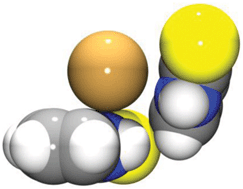The impact of the anion size on the crystal packing in 2-mercaptopyrimidine halides; isostructurality and polymorphism†
Abstract
The crystal structures of 2-mercaptopyrimidine (

* Corresponding authors
a
Faculty of Chemistry, Adam Mickiewicz University, Umultowska 90b, 61-614 Poznań, Poland
E-mail:
mkubicki@amu.edu.pl
Tel: +48 618291256
b Medical Physics Laboratory, Medical School, University of Ioannina, 45110 Ioannina, Greece
c Section of Inorganic and Analytical Chemistry, Department of Chemistry, University of Ioannina, 45110 Ioannina, Greece
The crystal structures of 2-mercaptopyrimidine (

 Please wait while we load your content...
Something went wrong. Try again?
Please wait while we load your content...
Something went wrong. Try again?
A. M. Owczarzak, N. Kourkoumelis, S. K. Hadjikakou and M. Kubicki, CrystEngComm, 2013, 15, 3607 DOI: 10.1039/C3CE40240A
To request permission to reproduce material from this article, please go to the Copyright Clearance Center request page.
If you are an author contributing to an RSC publication, you do not need to request permission provided correct acknowledgement is given.
If you are the author of this article, you do not need to request permission to reproduce figures and diagrams provided correct acknowledgement is given. If you want to reproduce the whole article in a third-party publication (excluding your thesis/dissertation for which permission is not required) please go to the Copyright Clearance Center request page.
Read more about how to correctly acknowledge RSC content.
 Fetching data from CrossRef.
Fetching data from CrossRef.
This may take some time to load.
Loading related content
